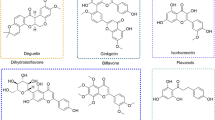Abstract
A considerable number of agents with chemotherapeutic potentials reported over the past years were shown to interfere with the reactions of DNA topoisomerases, the essential enzymes that regulate conformational changes in DNA topology. Gossypol, a naturally occurring bioactive phytochemical is a chemopreventive agent against various types of cancer cell growth with a reported activity on mammalian topoisomerase II. The compounds targeting topoisomerases vary in their mode of action; class I compounds act by stabilizing covalent topoisomerase-DNA complexes resulting in DNA strand breaks while class II compounds interfere with the catalytic function of topoisomerases without generating strand breaks. In this study, we report Gossypol as the interfering agent with type I topoisomerases as well. We also carried out an extensive set of assays to analyze the type of interference manifested by Gossypol on DNA topoisomerases. Our results strongly suggest that Gossypol is a potential class II inhibitor as it blocked DNA topoisomerase reactions with no consequently formed strand breaks.



Similar content being viewed by others
References
Wang, Y. C., & Rao, P. N. (1984). Effect of gossypol on DNA synthesis and cell cycle progression of mammalian cells in vitro. Cancer Research, 44, 35–38.
Moon, D. O., Choi, Y. H., Moon, S. K., Kim, W. J., & Kim, G. Y. (2011). Gossypol decreases tumor necrosis factor-α-induced intercellular adhesion molecule-1 expression via suppression of NF-κB activity. Food and Chemical Toxicology, 49, 999–1005.
Huang, Y. W., Wang, L. S., Chang, H. L., Ye, W., Sugimoto, Y., Dowd, M. K., et al. (2006). Effects of serum on (–)-gossypol-suppressed growth in human prostate cancer cells. Anticancer Research, 26, 3613–3620.
Volate, S. R., Kawasaki, B. T., Hurt, E. M., Milner, J. A., Kim, Y. S., White, J., et al. (2010). Gossypol induces apoptosis by activating p53 in prostate cancer cells and prostate tumor-initiating cells. Molecular Cancer Therapeutics, 9, 461–470.
Olgiati, K. L., & Toscano, W. A., Jr. (1983). Kinetics of gossypol inhibition of bovine lactate dehydrogenase X. Biochemical and Biophysical Research Communications, 115, 180–185.
Baumgrass, R., Weiwad, M., Erdmann, F., Liu, J. O., Wunderlich, D., Grabley, S., et al. (2001). Reversible inhibition of calcineurin by the polyphenolic aldehyde gossypol. Journal of Biological Chemistry, 276, 47914–47921.
Adlakha, R. C., Ashorn, C. L., Chan, D., & Zwelling, L. A. (1989). Modulation of 4′-(9-acridinylamino) metanesulfon-m-anisidide-induced, topoisomerase II-mediated DNA cleavage by gossypol. Cancer Research, 49, 2052–2058.
Wang, J. C. (1996). DNA topoisomerases. Annual Review Biochemistry, 65, 635–692.
Topcu, Z. (2001). DNA topoisomerases as targets for anticancer drugs. Journal of Clinical Pharmacy and Therapeutics, 26, 405–416.
Wang, J. C. (2002). Cellular roles of DNA topoisomerases: a molecular perspective. Nature Reviews, 3, 430–440.
D’Arpa, P., & Liu, L. F. (1989). Topoisomerase-targeting antitumor drugs. Biochimica et Biophysica Acta, 989, 163–177.
Hsiang, Y. H., & Liu, L. F. (1988). Identification of mammalian topoisomerase I as an intracellular target of the anticancer drug camptothecin. Cancer Research, 26, 1722–1726.
Sordet, O., Khan, Q. A., & Pommier, Y. (2004). Apoptotic topoisomerase I-DNA complexes induced by oxygen radicals and mitochondrial dysfunction. Cell Cycle, 3, 1095–1097.
Galvez, M., Martín-Cordero, C., & Ayuso, M. J. (2005). Iridoids as DNA topoisomerase I poisons. Journal of Enzyme Inhibition and Medicinal Chemistry, 20, 389–392.
Ishar, M. P., Singh, G., Singh, S., Sreenivasan, K. K., & Singh, G. (2006). Design, synthesis, and evaluation of novel 6-chloro-/fluorochromone derivatives as potential topoisomerase inhibitor anticancer agents. Bioorganic & Medicinal Chemistry Letters, 16, 1366–1370.
Kucukoglu, O., Ozturk, B., Kamataki, T., & Topcu, Z. (2006). Inhibitory activities of Helichrysum taxa on mammalian type I DNA topoisomerase. Pharmaceutical Biology, 44, 189–193.
Alpan, S., Gunes, S., & Topcu, Z. (2007). 1H-Benzimidazole derivatives as mammalian DNA topoisomerase I inhibitors. Acta Biochimica Polonica, 54, 561–565.
Canturk, P., Kucukoglu, K., Topcu, Z., Gul, M., & Gul, H. I. (2008). Effect of some bis-Mannich bases and corresponding piperidinols on DNA topoisomerase I. Arzneimittel Forschung, 58, 686–691.
Topcu, Z., Ozturk, B., Kucukoglu, O., & Kilinc, E. (2008). Flavonoids in Helichrysum pamphylicum inhibit mammalian type I DNA topoisomerase. Zeitschrift für Naturforschung C, 63, 69–74.
Coban, G., Zencir, S., Zupkó, I., Réthy, B., Gunes, H. S., & Topcu, Z. (2009). Synthesis and biological activity evaluation of 1H-benzimidazoles via mammalian DNA topoisomerase I and cytostaticity assays. European Journal of Medicinal Chemistry, 44, 2280–2285.
Sarikaya, D., Bilgen, C., Kamataki, T., & Topcu, Z. (2006). Comparative cytochrome P450–1A1, −2A6, −2B6, −2C, −2D6, −2E1, −3A5 and −4B1 expressions in human larynx tissue analysed at mRNA level. Biopharmaceutics & Drug Disposition, 27, 353–359.
Mete, E., Gul, H. I., Canturk, P., & Topcu, Z. (2010). Biological activity of 1-aryl-3-phenethylamino-1-propanone hydrochlorides and 3-aroyl-4-aryl-1-phenethyl-4-piperidinols on PC-3 cells and DNA topoisomerase I enzyme. Zeitschrift für Naturforschung C, 65, 647–652.
Marini, J. C., Miller, K. G., & Englund, P. T. (1980). Decatenation of kinetoplast DNA by topoisomerases. Journal of Biological Chemistry, 255, 4976–4979.
Acknowledgments
This study was supported by The Scientific and Technological Research Council of Turkey (TUBITAK) (Grant no. TBAG108T548 to ZT).
Author information
Authors and Affiliations
Corresponding author
Rights and permissions
About this article
Cite this article
Senarisoy, M., Canturk, P., Zencir, S. et al. Gossypol Interferes with Both Type I and Type II Topoisomerase Activities Without Generating Strand Breaks. Cell Biochem Biophys 66, 199–204 (2013). https://doi.org/10.1007/s12013-012-9468-5
Published:
Issue Date:
DOI: https://doi.org/10.1007/s12013-012-9468-5




